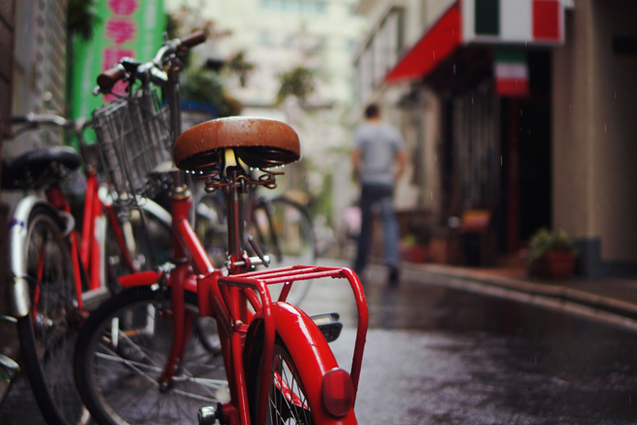|
When 5,000 people were asked what helped with depression, exercise came out as the most effective. But what if you are one of those people who find the idea of exercise a turn off? What if there was a way of getting out and about, and getting exercise, without it feeling like exercise?
When I think of exercise, I think of going to a gym, swimming, or jogging. I have done these things in the past. I find that while I like the feeling of better fitness, I don't really enjoy the activity. And importantly I find I have to make time out of my day to do them, so I don't keep them up. This is what happens for lots of people. For many people, exercise is more a question of finding something you enjoy doing, which also involves being active. Cycling for me is one of those activities. So why cycle?
It's a practical alternative to driving or walking.
If I drive, I usually end up queuing in traffic, struggling to find a parking space, and then I am still some distance from where I need to get to. By the time I have done all that in a car, I will have already locked my bike up pretty much right outside where I am going. Over short distances, 3 miles or less, cycling around town is as quick, if not quicker than driving. Even over longer distances there is often very little in it. I have a weekly 6 mile commute to another office, and because of traffic there is about a 5 minute time difference. Also parking is scarce and costs a fortune. Apart from never having to pay for parking, the other important point is that cycling is more relaxing than driving. On a bike, I can look about and take in the scenery more. I am also very rarely if ever held up by traffic. This feature of cycling - a feeling of always being on the move - is much pleasanter than the frustration of stop start when I'm driving. In my previous job, being able to get on my bike, and cycle out the stress was really useful in helping me cope with difficult working conditions. If I had driven home, the rush hour traffic would have tended to add to my stress. For short journeys, cycling is as quick, often more convenient, cheaper, more relaxing, and you will be getting some of that all important exercise. Mindfulness on a bike
You can also be mindful while you are cycling. I find the following practices helpful in enabling me to cycle 'mindfully'.
The practicalitiesIf you are thinking about cycling and are not sure whether it is for you, then you may want to consider getting some training. You may also consider this if you are nervous about cycling and want to improve your confidence. The My Journey website have a list of fully qualified National Standards Instructors in the Southampton area. Getting the right bike
Just as a car is designed for different purposes, so are bicycles. A bike intended for riding over rocky trails will be very different to a bike meant to be ridden fast on smooth roads.
The best bike for most people is something known as a hybrid, which is a mix between a racing road bike and a trail bike. Hybrids are good for riding along rough paths, and over poor road surfaces, while still being reasonably quick on the road. They generally have a more comfortable upright position with flat bars. They can also be fitted with practical things like mudguards and pannier racks. If you are unsure of what to get, the best way to buy a bike is to go to a local bike shop, and ask them to help you. Tell them what you want to use the bike for, and your budget. You can get a good quality bike for between £200 and £400. This will also give you an opportunity to have a test ride to check the bike works for you. The cycle shop should set the bike up for you, and fit any other items such as mudguards or racks you might want. Where to ride
The single biggest concern for most people is riding in traffic.
There are two kinds of safety which are important. One is objective safety - this is the safety which looks at accident risk. Looking at it this way, cycling, even on the road is a very safe activity, safer by some measures than walking. The other kind is subjective safety. This is how safe you feel, and most people feel very unsafe when a bigger and faster vehicle approaches from behind and sweeps by too closely. Feeling safe is as important as being safe - cycling is meant to be relaxing and fun, and if it isn't there is little point doing it.
You can find out about cycle routes from your local council, who will often produce cycle maps of the area, such as this one by Southampton City Council. I quite like using Google Maps, which will create a route using available cycle paths, such as this one from Eastleigh to Southampton. What to wear
You do not need to kit yourself out in lycra to ride a bicycle. The reason cycle clothing is so figure hugging has more to do with improved aerodynamics for racing cyclists, than anything else. Their other advantage is that unlike cotton, synthetic fabrics do not absorb moisture, so they are more comfortable when you sweat. Padded lycra shorts can be worth wearing if you are thinking of doing longer distances as it will reduce saddle soreness.
All you really need are clothes which allow you freedom of movement for your legs, and your hands to comfortably reach the handlebars, which is most clothing. You might want to avoid wearing jeans, which can be heavy, while the slim cut versions can restrict your leg movements. With footwear you want shoes which allow you to place the ball of your foot on the centre of the pedal, and won't slip off easily, which is pretty much any rubber soled shoe or trainer. If you intend to ride in the rain, you will want good quality waterproofs. It's a good idea to make sure they are as lightweight as possible, because they will tend to make you hot. If you are riding in cold weather you will need insulating gloves for your hands, and if it is very cold some kind of protection for your face. For your body, keeping warm is all about windproofing rather than insulation. It has to get really cold before I even need to put a jumper on underneath my waterproof. Should you wear a helmet? The answer to this question is not as clear cut as it first appears. A properly fastened cycle helmet will offer good, though not complete protection in the event you fall off your bike and hit your head on the road. Early studies on cycle helmets showed clear protective effects, which led to various nations, such as the USA and Australia, bringing in compulsory helmet laws. This paradoxically had no effect on injury rates, which in some cases rose, even though cycling rates universally fell after the introduction of legislation. No one is completely sure why this is. If you are interested in this area cyclehelmets.org offers summaries of the main research. When it comes to avoiding injury, how safely you ride is many times more important than whether or not you wear a helmet. Looking after your bike
Bicycles are generally pretty tolerant and durable, unless you ride them off road through mud and muck, which will tend to break them pretty quickly.
However you ride, your three main routine maintenance tasks are ,
Depending on how you ride and look after your bike, the chain, brake pads, and tires will typically last somewhere between 3 and 4,000 miles before they need replacing. If you are not mechanically minded your local bike shop can service your bike for you. Fixing a puncture is one task that's worth learning how to do yourself, and this video by Jules from Evans Cycles offers a good explanation of how to go about this.
I have talked about cycling and depression because cycling is something I know quite a lot about. If cycling isn't for you, maybe you have some ideas on how to incorporate an everyday activity which also means being physically active into your routine.
If you are thinking about cycling and want to find out some more about how to get into cycling, you may find these beginner articles of interest, Getting started cycling by NHS choices Cycling for Beginners? Start Here! by Bike Radar Articles for Beginning Cycling by cycling legend Sheldon Brown The Ultimate Beginner's Guide to Bicycling by Bicycling Getting into Bicycling by rei.com Footnote #1 Is it illegal to cycle on the pavement?
main picture by Unsplash
0 Comments
Leave a Reply. |
Categories
All
Archives
January 2021
|
BioI'm Mark, a Humanistic Counsellor. |
Home - Testimonials - Articles - Links - Contact - Book Appointment - Counselling Students - Privacy Policy - Terms
Mark Redwood, BA (Hons) Counselling, MBACP
© Mark Redwood 2015, 2016.2017 | Main portrait by Doug Freegard © 2015


 RSS Feed
RSS Feed